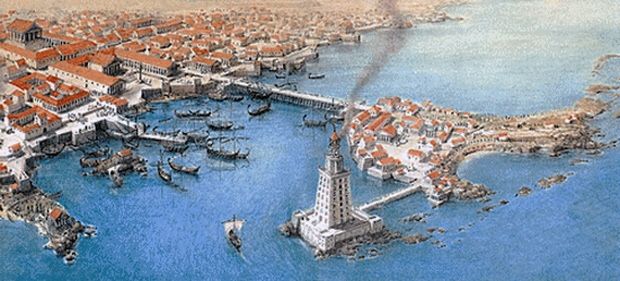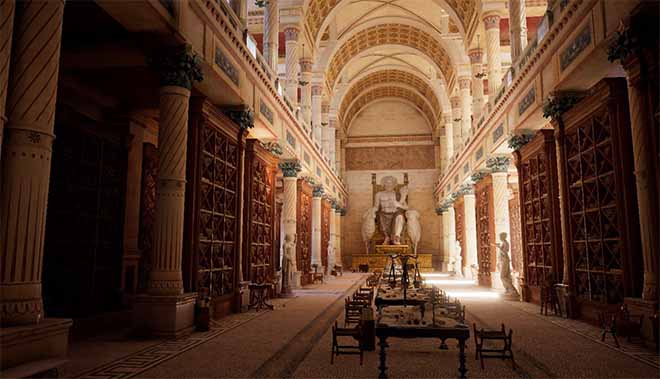Ancient Alexandria - The Pharos Lighthouse And Great Library
The Gigantism of Alexander the Great

Seventh wonder of the ancient world, the Pharos Lighthouse of Alexandria stood at the entrance to the port of the city founded by Alexander the Great in 331 BC and built by his successor, Ptolemy 1st.
The pharos lighthouse : the queen seat of the port of Alexandria
Alexandria is conceived as an ideal city, whose gigantism reflects the power of Hellenistic domination of the Mediterranean. The magnificence and height of the Pharos Lighthouse is the most striking symbol. It remains today after its destruction in 1303 a chaos of limestone blocks immersed off Alexandria, and more or less precise descriptions; nothing to restore its appearance with certainty.
The island of Pharos hosts the seventh wonder of the world

The construction of a lighthouse in Alexandria first responds to a utilitarian concern. The survival of the city is due to the good development of its maritime trade. It is therefore of utmost importance to ensure the safety of the boats and to guide them in an area that Strabo (born in 58 BC) described as "full of reefs, some of which are flush with the sea water levels, the others invisible.
The lighthouse is built on the eastern tip of an oblong island that faces the city: the island of Pharos. It is from the name of this island that is derived the common name "lighthouse" (pharus in Latin), which we inherited. The island is connected to the mainland by a dike of more than one kilometer, forming a well sheltered port.
Pharaonic works, as it should be
Ptolemy I, former general of Alexander the Great, founder of a dynasty that died with the death of Cleopatra in 30 BC, wants to be the worthy heir of the pharaohs. For the construction of the Pharos lighthouse, he puts to work all the holders of the Egyptian know-how. Priests and craftsmen have access to the methods of construction of the pyramids, thanks notably to the works kept in the Great Library of Alexandria.
The result must have been grandiose. It was without a doubt. The literary and archaeological sources make it possible to draw out the major outlines. Built in blocks of white limestone, it is probably 135 meters high. The first floor is square, the second is an octagon and finally the third and last floor is cylindrical. The whole is based on a raised rectangular base. A ramp resting on 16 arches gives access to the monumental gateway to the Lighthouse. The climb inside is done by a ramp to the second floor, then by a staircase to the top.
The whole thing was, Yacoubi tells us, an Arab civil servant of the nineteenth century, "pierced in all its parts of windows intended to provide room for people who climb so that they can properly place their feet". About fifty rooms are used to accommodate the maintenance staff and store the fuel regularly delivered to the top of the tower.
The different destinies of the Pharos lighthouse
The key element of the Pharos lighthouse of Alexandria is its top floor. It includes the "fire chamber" whose fire is active day and night, illuminating more than 100 nautical miles. The statues of the Greek pantheon that crown the tower are most probably replaced by Christian statues (perhaps that of Saint Mark, the patron saint of the city) during the Byzantine period (4th-7th centuries). When Muslims take possession of the city, they transform the top floor into a mosque. Today, its reconstruction is far from complete; it is due to the long and meticulous work of archaeologists who have to pick up the pieces of a puzzle of nearly 3000 blocks lying several meters deep.
What did the Great Library of Alexandria contain ?

Pursuing the dreams of gigantism of Alexander the Great, Ptolemy I presided over the construction of Alexandria. Convinced by the philosopher Demetrius of Phalerum that his city must have a library, it is the largest work warehouse in the ancient Mediterranean world.
The Ptolemy want to collect all possible writings of the known world. This is done through purchases, copies, but also stealing ... These thousands of scrolls garnish shelves distributed in the palace district, under the porticoes or in the corridors.
There are the works of Homer, Herodotus or Thucydides as well as the translation of the Jewish Bible, the Septuagint. Such concentration attracts the greatest intellectuals of the time. The Great Library of Alexandria has counted up to 700,000 scrolls, it is thought.









































































































































































































































































































































